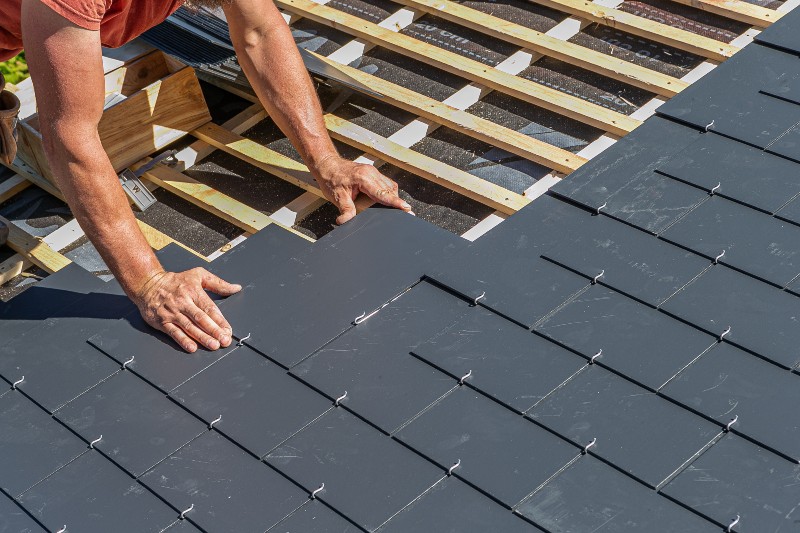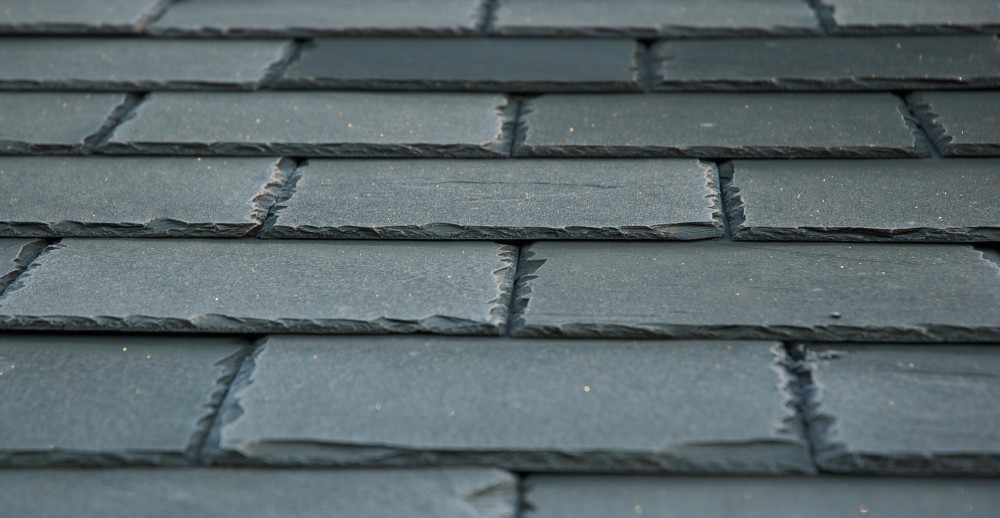Here in Colorado, roofs of all shapes and styles are used to protect commercial and residential buildings from ongoing exposure to the elements.
Some roofing materials do a better job at doing this than others. Building location, elevation, microclimate, and how the building is used are all contributing factors that determine what roofing material is best for long-term protection.
For design appeal and durability, slate roofs can be an excellent choice. However, they’re not without their disadvantages. In this article, your go-to roofing experts at A-to-Z Roofing & Exteriors will be explaining the anatomy of a typical slate roof and detailing the pros and cons that come with choosing this attractive and long-lasting roofing material.
How Slate Roofing Is Made
Contrary to asphalt shingles that are composed using tar, sand, and fiberglass matting, the fundamental composition of traditional slate roofing is much simpler. Slate is made from shale sediment that is composed mostly of clay. In some cases, clay combined with volcanic ash can be the base material for slate tiles, depending on where the slate was produced.
Slate is incredibly tough, yet it can be easily broken into custom-sized tiles that are thin yet very durable. This makes it an ideal roofing material that can provide reliable protection lasting 75 years or more.
The process used to create slate starts by quarrying stone from pits and mines located throughout the world. Extraction of metamorphic deposits requires the use of highly specialized quarrying machinery and controlled explosions that ‘unlock’ the rocky substance from its location at or near the surface.
After the massive slabs of slate have been quarried, they’re transported to cutting and refining factories that size and condition them for either of two uses: roofing or architectural.
Roofing Slate is typically thin and standardized to specific dimensions according to the slate material distributor. This is the slate you’ll find on many homes throughout Colorado.
Architectural Slate can be cut and joined to create all kinds of unique architectural features, from exterior walls to flooring and even bathtubs and countertops.

Pros and Cons of Slate Roofs in Colorado
Now that we’ve explored the production of slate as a construction material, let’s identify the advantages and disadvantages slate has when used as a component of an overall roofing system.
Pros of Slate Roofs
Beautiful aesthetics is one of the clearest advantages that slate has in comparison to other roofing alternatives. Nothing looks as stately or as regal as a well-built slate rooftop, and there’s a reason why slate has been used on some of the most inspiring buildings throughout modern human history (the first slate roof was constructed in the 1300s). It truly is one of the most attractive roofing materials in existence, and, as it ages, slate will often develop a rustic, multicolored patina that adds to its grandeur.
Another pro for slate roofing is its lifespan. While asphalt or membranous roofing systems can be expected to last between 20 and 35 years in most cases, a slate roof can easily last for twice or even three times that amount of time.
Slate tile manufacturers will often warranty their products for 40 years at a minimum, and because of the strength of slate, the tiles themselves will stand up to even the harshest weather, season after season.
Slate roofs not only look great and last for a long time; they’re also very low maintenance. Once in place, slate roof tiles don’t need to be repositioned or regularly coated or treated. On the rare occasion that a slate tile does become damaged, it’s very easy to repair it with a drop-in replacement tile.
Lastly, slate roofs immediately increase the value of a home, presuming it didn’t have a slate roof before. Slate roofs hold their value for much, much longer than asphalt, metal, or wood shake roofs, making an investment into a slate roof a smart move for homeowners.
Cons of Slate Roofs
The first downside you’ll often hear mentioned in any conversation about slate roofs is their cost.
Slate roofing is by far the most expensive roofing material on the market today. It’s not uncommon for a slate roof to cost between $15-$20 per square foot. This is largely due to the cost of quarrying the base material, sizing it, and shipping it to distributors.
Another factor that contributes to the high cost of slate roofs is the expertise required for installation. Slate roofs involve a lot more time and planning to properly install, and the technicians who work with slate tiles need additional training above and beyond what they would need for standard asphalt shingles.
Another con of slate roofs is their weight. Because each tile is literally made of stone, the total weight of a slate roof can be expected to be 3-4 times as heavy as a traditional asphalt shingle roof. Because of this, additional roof supports might need to be installed in order to preserve the structural integrity of the building.
Have Questions about Slate Roof Installation? Contact Us!
Want to learn more about slate roofs? Or, are you considering having a slate roof installed on your home?
Contact A-to-Z Roofing today, and we’ll be happy to address all of your questions and concerns.

